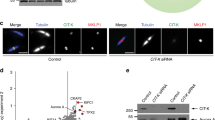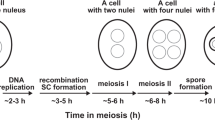Abstract
Proteins containing formin homology domains, FH1 and FH2, are involved in cytokinesis or establishment of cell polarity in a variety of organisms. Bni1p and Bnr1p are FH proteins and potential targets of the Rho family small GTP-binding proteins in S. cerevisiae. We have shown that Bnr1p is localized at the bud neck to interact with Hof1p, involved in cytokinesis. We report here that the overexpression of BNR1 causes a cytokinesis deficiency which is similar to the phenotypes of the septin mutants, including cdc3, cdc10, cdc11, and cdc12. The region required for the septin mutant phenotypes was mapped to Bnr1p (35 – 500), which coincided with the region required for the bud-neck localization. To further isolate a gene interacting with BNI1 or BNR1, a multicopy suppressor of the bni1 bnr1 mutant was isolated. This gene encoded Smy1p, a kinesin-related protein. Bnr1p, but not Bni1p, directly interacted with the C-terminal region of Smy1p. The Smy1p-interacting region of Bnr1p was mapped to a region containing the FH2 domain. Bnr1p also directly interacted with Bud6p, a novel actin-binding protein. Bnr1p is thus a multi-functional protein which interacts with the septin system, a microtubule-dependent motor protein, and the actin system, to regulate cytoskeletal functions in S. cerevisiae.
This is a preview of subscription content, access via your institution
Access options
Subscribe to this journal
Receive 50 print issues and online access
$259.00 per year
only $5.18 per issue
Buy this article
- Purchase on Springer Link
- Instant access to full article PDF
Prices may be subject to local taxes which are calculated during checkout








Similar content being viewed by others
References
Bartel P, Chien CT, Sternglanz R and Fields S. . 1993 Biotechniques 14: 920–924.
Bradford MM. . 1976 Anal. Biochem. 72: 248–254.
Carroll CW, Altman R, Schieltz D, Yates JR and Kellogg D. . 1998 J. Cell Biol. 143: 709–717.
Cid VJ, Duran A, del-Rey F, Snyder MP, Nombela C and Sanchez M. . 1995 Microbiol. Rev. 59: 345–386.
Evangelista M, Blundell K, Longtine MS, Chow CJ, Adames N, Pringle JR, Peter M and Boone C. . 1997 Science 276: 118–122.
Flescher EG, Madden K and Snyder M. . 1993 J. Cell Biol. 122: 373–386.
Frazier JA and Field CM. . 1997 Curr. Biol. 7: R414–R417.
Fujiwara T, Tanaka K, Mino A, Kikyo M, Takahashi K, Shimizu K and Takai Y. . 1998 Mol. Biol. Cell 9: 1221–1233.
Gietz D, Jean AS, Woods RA and Schiestl RH. . 1992 Nucleic Acids Res. 20: 1425.
Giot L and Konopka JB. . 1997 Mol. Biol. Cell 8: 987–998.
di Guan C, Li P, Riggs PD and Inouye H. . 1988 Gene 67: 21–30.
Guarente L. . 1983 Methods Enzymol. 101: 181–191.
Hall A. . 1994 Annu. Rev. Cell Biol. 10: 31–54.
Hall A. . 1998 Science 279: 509–514.
Hartwell LH. . 1971 Exp. Cell Res. 69: 265–276.
Hill JE, Myers AM, Koerner TJ and Tzagoloff A. . 1986 Yeast 2: 163–167.
Imamura H, Tanaka K, Hihara T, Umikawa M, Kamei T, Takahashi K, Sasaki T and Takai Y. . 1997 EMBO J. 16: 2745–2755.
Kamei T, Tanaka K, Hihara T, Umikawa M, Imamura H, Kikyo M, Ozaki K and Takai Y. . 1998 J. Biol. Chem. 273: 28341–28345.
Kikuchi A, Kuroda S, Sasaki T, Kotani K, Hirata K, Katayama M and Takai Y. . 1992 J. Biol. Chem. 267: 14611–14615.
Kohno H, Tanaka K, Mino A, Umikawa M, Imamura H, Fujiwara T, Fujita Y, Hotta K, Qadota H, Watanabe T, Ohya Y and Takai Y. . 1996 EMBO J. 15: 6060–6068.
Laemmli UK. . 1970 Nature 227: 680–685.
Lillie SH and Brown SS. . 1992 Nature 356: 358–361.
Lillie SH and Brown SS. . 1998 J. Cell Biol. 140: 873–883.
Longtine MS, DeMarini DJ, Valencik ML, Al-Awar OS, Fares H, De Virgilio C and Pringle JR. . 1996 Curr. Opin. Cell Biol. 8: 106–119.
Longtine MS, Fares H and Pringle JR. . 1998 J. Cell Biol. 143: 719–736.
Mino A, Tanaka K, Kamei T, Umikawa M, Fujiwara T and Takai Y. . 1998 Biochem. Biophys. Res. Commun. 251: 732–736.
Nakatsuru S, Sudo K and Nakamura Y. . 1994 Biochem. Biophys. Res. Commun. 202: 82–87.
Ozaki K, Tanaka K, Imamura H, Hihara T, Kameyama T, Nonaka H, Hirano H, Matsuura Y and Takai Y. . 1996 EMBO J. 15: 2196–2207.
Pringle JR. . 1991 Methods Enzymol. 194: 732–735.
Sambrook J, Fritsch EF and Maniatis T . Eds. 1989 Molecular Cloning: A Laboratory Manual. Cold Spring Harbor Laboratory: Cold Spring Harbor, New York.
Sanders SL and Field CM. . 1994 Curr. Biol. 4: 907–910.
Sherman F, Fink GR and Hicks JB . Eds. 1986 Methods in Yeast Genetics. Cold Spring Harbor Laboratory: Cold Spring Harbor, New York.
Sikorski RS and Hieter P. . 1989 Genetics 122: 19–27.
Takai Y, Sasaki T, Tanaka K and Nakanishi H. . 1995 Trends Biochem. Sci. 20: 227–231.
Tanaka K and Takai Y. . 1998 Curr. Opin. Cell Biol. 10: 112–116.
Umikawa M, Tanaka K, Kamei T, Shimizu K, Imamura H, Sasaki T and Takai Y. . 1998 Oncogene 16: 2011–2016.
Vojtek AB, Hollenberg SM and Cooper JA. . 1993 Cell 74: 205–214.
Wasserman S. . 1998 Trends Cell Biol. 8: 111–115.
Yamochi W, Tanaka K, Nonaka H, Maeda A, Musha T and Takai Y. . 1994 J. Cell Biol. 125: 1077–1093.
Acknowledgements
We thank John Pringle (University of North Carolina) for the anti-Cdc11p antibody. This investigation was supported by grants-in-aid for Scientific Research and for Cancer Research from the Ministry of Education, Science, Sports and Culture, Japan (1999), by grants-in-aid for Abnormalities in Hormone Receptor Mechanisms and for Aging and Health from the Ministry of Health and Welfare, Japan (1999), and by grants from the Human Frontier Science Program (1998) and the Uehara Memorial Foundation (1998).
Author information
Authors and Affiliations
Rights and permissions
About this article
Cite this article
Kikyo, M., Tanaka, K., Kamei, T. et al. An FH domain-containing Bnr1p is a multifunctional protein interacting with a variety of cytoskeletal proteins in Saccharomyces cerevisiae. Oncogene 18, 7046–7054 (1999). https://doi.org/10.1038/sj.onc.1203184
Received:
Revised:
Accepted:
Published:
Issue Date:
DOI: https://doi.org/10.1038/sj.onc.1203184
Keywords
This article is cited by
-
An optogenetic system to control membrane phospholipid asymmetry through flippase activation in budding yeast
Scientific Reports (2020)
-
Unleashing formins to remodel the actin and microtubule cytoskeletons
Nature Reviews Molecular Cell Biology (2010)
-
Formins direct Arp2/3-independent actin filament assembly to polarize cell growth in yeast
Nature Cell Biology (2002)



